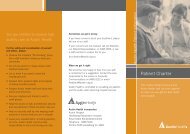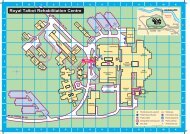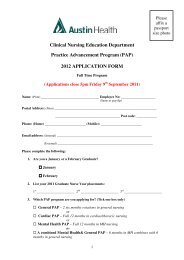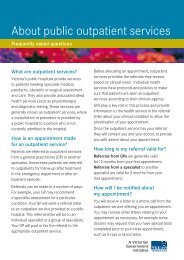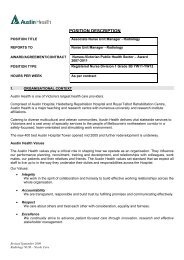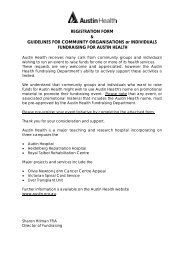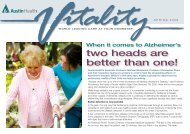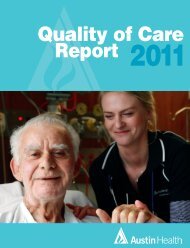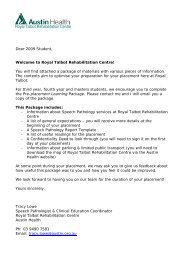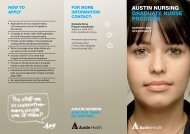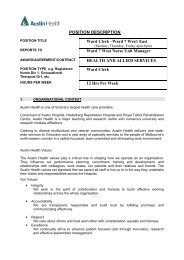Emergency Department Research Report 2009 - Austin Health
Emergency Department Research Report 2009 - Austin Health
Emergency Department Research Report 2009 - Austin Health
Create successful ePaper yourself
Turn your PDF publications into a flip-book with our unique Google optimized e-Paper software.
<strong>Austin</strong> Hospital <strong>Emergency</strong> <strong>Department</strong><strong>Research</strong> <strong>Report</strong> <strong>2009</strong>Compiled byA/Prof David TaylorDirector of <strong>Emergency</strong> and General Medicine <strong>Research</strong>
FOREWORDWithout question, <strong>2009</strong> was our most active and productive research year to date. Asour patient census continued to increase, so did our research activity. In all areas, weexceeded earlier achievements and broke new ground in other areas of research aswell. It is clear that our department is developing a reputation within the AustralasianCollege for <strong>Emergency</strong> Medicine (ACEM), and elsewhere, as a leader in emergencymedicine research.We extend our congratulations to Drs Anselm Wong, Mark Rugless, Kirsty Jackson,Peter Cheng and Saad Al-Noaman all of whom successfully completed theirRegulation 4.10 training requirements in <strong>2009</strong>. This involved presentation of theiroriginal research projects at an ACEM national or regional conference.Congratulations are also extended to Simone Taylor and Andrew Harding, two of ourED pharmacists. As well as actively contributing to other research activities, bothsuccessfully completed the Pharmacist Independent Prescribers’ course offered by theRobert Gordon University, Aberdeen, Scotland.Our staff were fortunate to win three research prizes during <strong>2009</strong>. Esther Chan,formerly our ED pharmacist and now <strong>Research</strong> Fellow, won the <strong>2009</strong> DBL YoungPharmacists Award from the Society of Hospital Pharmacists of Australia. JoRichardson and I won the <strong>2009</strong> John Gilroy Potts Award for the most significantpublication by an ACEM Fellow. I also won the Best Paper presented by a Fellow atthe ACEM Annual Scientific Meeting.Our Advanced Medical Science (AMS) student research program continued to dowell. Each of our 2008 students published their work and our <strong>2009</strong> students have theirresearch under peer review at the moment. Last year, Charles Xie investigated thediffering bacteriology and antibiotic sensitivity of nursing home and generalcommunity residents. Jeremy Kam investigated the effect of obesity on the difficultyof managing emergency department patients. Dean Page continued our department’sinterest in vapocoolant spray and undertook a randomised trial comparingvapocoolant directly with subcutaneous lignocaine to reduce the pain of intravenouscannulation.It is pleasing to note that the three AMS students who began with us in <strong>2009</strong> haveinteresting projects that are progressing well. John Chae is running a randomised trialcomparing the efficacy of metoclopramide and tropisetron for nausea and vomiting.Kathy Jao is running two pre- and post-intervention studies evaluating both adult andpaediatric nurse-initiated analgesia programs. Munad Khan is examining the effect ofcomplementary medicines on the INR stability of patients taking warfarin.The great majority of our research activity is undertaken on a shoestring budget. Lastyear, however, we were successful in being awarded a number of grants that aredescribed below. The most important was an NHMRC grant to support our ‘CodeGrey’ collaborative research into sedation of the acutely agitated patient. No doubtthis funding will afford us some breathing space as we look forward to other projects.Meanwhile, this large randomised trial is progressing well at its three sites (<strong>Austin</strong>,RMH, St V’s)
Last year saw the completion of the ‘<strong>Emergency</strong> <strong>Department</strong> Procedural Sedation’study, a national collaborative of 11 emergency departments run by the <strong>Austin</strong>.Although a lot of hard work, this project was immensely successful and took out a topaward at the ACEM national conference last November. Presently we are working onthree major papers for publication.While our success last year is very pleasing, it is likely that our activity will plateau inthe near future as a result of resource limitations. Herein lies the next challenge. Weneed to explore all possibilities that will allow us to consolidate and expand. Theseextend beyond grant funding and may include Fellowship programs, dedicatedregistrar research positions, and expansion of collaborations both within and outsideof the <strong>Austin</strong>.Finally, I would like to congratulate those staff who have had successful researchendeavours during <strong>2009</strong> and thank those who assisted and facilitated this good work.DT
RESEARCH ARTICLESArticles Published:Chan E, Taylor SE, Marriott J, Barger B. Exploration of attitudes and barriers tobringing patient’s own medications to the <strong>Emergency</strong> <strong>Department</strong>: A survey ofparamedics. J Emerg Primary <strong>Health</strong> Care <strong>2009</strong>; 6: article number 990313Chan EW, Taylor SE, Marriott JL, Barger B. Bringing patients' own medications intoan <strong>Emergency</strong> <strong>Department</strong> by ambulance: effect on prescribing accuracy when thesepatients are admitted to hospital. MJA <strong>2009</strong>; 191: 374-7Cabalag MS, Taylor DMcD, Knott JC, Buntine P, Smit DeV, Meyer A. Recentcaffeine ingestion reduces adenosine efficacy in the treatment of paroxysmalsupraventricular tachycardia.Published on line ahead of print: Acad Emerg Med <strong>2009</strong>; 16: 1-6Hijazi R, Taylor DMcD, Richardson J. Topical alkane vapocoolant spray reducesintravenous cannulation pain in emergency department patients: a randomised,double-blind, placebo-controlled trial. Br Med J <strong>2009</strong>; 338: 457-459 (b215)Hewat N, Taylor DMcD, MacDonald E. Pilot study of Random Finger Prick Glucosetesting as a screening tool for Type 2 Diabetes Mellitus in the <strong>Emergency</strong><strong>Department</strong>. Emerg Med J <strong>2009</strong>; 26: 732-733Thom O, Taylor DMcD, Wolfe RE, Myles P, Krum H, Wolfe R. Comparison of asupra-sternal cardiac output monitor (USCOM) with the pulmonary artery catheterBr J Anaesth <strong>2009</strong>; 103: 800-804Tran A, Taylor DMcD. Medical model for Hospital in the Home: effects on patientmanagement. Aust <strong>Health</strong> Rev <strong>2009</strong>; 33: 494-501Taylor DMcD, Robinson J, MacLeod D, MacBean CE, Braitberg G. Therapeuticerrors involving adults in the community setting: nature, causes and outcomes.Aust NZ J Pub <strong>Health</strong> <strong>2009</strong>; 33: 388-394Rajasagaram U, Taylor DMcD, Braitberg G, Pearsell J, Capp B. Paediatric painassessment: differences between triage nurse, child and parent.J Paed Child <strong>Health</strong> <strong>2009</strong>; 45: 100-203Singh R, Taylor DMcD, D’Souza D, Gorelik A, Page P, Phal P. Injuries significantlyassociated with thoracic spine fractures: a case-control study.Emerg Med Australas <strong>2009</strong>; 21: 419-423Chan E, Knott JC, Taylor DMcD, Phillips G, Kong D. Intravenous olanzapine –another potential option for the acutely agitated patient? (Letter)Emerg Med Australas <strong>2009</strong>; 21: 241–242Yeoh BSK, Taylor DMcD, Taylor SE. An education initiative improves the evidencebaseduse of metoclopramide following morphine administration in the emergencydepartment. Emerg Med Australas <strong>2009</strong>; 21: 178–183
Taylor DMcD, Taylor SE, Ho J, Cabalag M, Hijazi R, Howden B, Charles P. Theeffects of nebulised N-acetylcysteine on sputum quality and diagnostic yield.J Pharm Prac Res <strong>2009</strong>; 39: 24-27Taylor DMcD, Robinson J, MacLeod D, MacBean CE, Braitberg G. Therapeuticerrors among children in the community setting: nature, causes and outcomes.J Paed Child <strong>Health</strong> <strong>2009</strong>; 45: 304-309Simpson N, Page P, Taylor DMcD. Free fluid accumulation following bluntabdominal trauma: potential for expansion of the FAST protocol. HKJEM <strong>2009</strong>; 17:1-6Mohd Rosli R, Taylor DMcD, Knott JC, Das A, Dent AW. <strong>Health</strong> smart cards:differing perceptions of emergency department staff and patients.Aust <strong>Health</strong> Rev <strong>2009</strong>; 33: 136-143Yeoh M. ‘From other journals’ Emerg Med Australas 2008; 21: 524-5 Emerg Med Australas 2008; 21: 427-9 Emerg Med Australas 2008; 21: 336-8 Emerg Med Australas 2008; 21: 243-5 Emerg Med Australas 2008; 21: 163-5 Emerg Med Australas 2008; 21: 88-9Articles accepted for publication (In press):Taylor DMcD. Pre-procedural fasting for sedation. Do we need to do it? (InvitedEditorial) Accepted Emerg Med J November 15, <strong>2009</strong>. In pressHo J, Taylor DMcD, Cabalag MS, Ugoni AM, Yeoh M. Factors that impact upon<strong>Emergency</strong> <strong>Department</strong> patient compliance with antibiotic regimens.Accepted Emerg Med J October 21, <strong>2009</strong>. In pressThom O, Taylor DMcD, Wolfe RE, Myles P, Krum H, Wolfe R. Pilot study of theprevalence, outcomes and detection of occult hypoperfusion in trauma patientsAccepted Emerg Med J, August 25, <strong>2009</strong>. In pressArticles undergoing peer reviewKam J, Taylor DMcD. The effects of obesity in increasing the difficulty of patientmanagement in the <strong>Emergency</strong> <strong>Department</strong>Submitted to Annals Emerg Med February 3, 2010Page DE, Taylor DMcD. Vapocoolant spray versus subcutaneous lidocaine injectionfor reducing the pain of intravenous cannulation: a randomized, controlled, clinicaltrial. Submitted to JAMA February 3, 2010
Xie C, Taylor DMcD, Howden BP, Charles PGP. Comparison of the bacterial isolatesand antibiotic resistance patterns of elderly nursing home and general communitypatients. Submitted to Clin Microbiol Infect February 2, 2010Wong A, Taylor DMcD, Ashby K, Robinson J. The changing epidemiology ofantidepressant drug overdose in Victoria, Australia.Submitted to Aust NZ J Psychiatry January 5, 2010Singh R, Taylor DMcD, D’Souza D, Gorelik A, Page P, Phal P. Mechanism of injuryand clinical variables associated with thoracic spine fracture.Revision submitted to Int J Emerg Med, November 25, <strong>2009</strong>Bernard S, Smith K, Cameron P, Masci K, Taylor D, Cooper J, Kelly A-M. Inductionof therapeutic hypothermia by paramedics following resuscitation from out-ofhospitalventricular fibrillation cardiac arrest: A randomized, controlled trialRevision submitted to Circulation January 3, 2010
CONFERENCE/SEMINAR ORAL PRESENTATIONSSimon Judkins‘<strong>Emergency</strong> Care : 3-2-1. Improving <strong>Emergency</strong> <strong>Department</strong> Patient Flow at <strong>Austin</strong><strong>Health</strong>’ Redesigning <strong>Health</strong> Care Summit. September <strong>2009</strong>Michael YeohNICS Evidence into Action workshop.Australasian College for <strong>Emergency</strong> Medicine, Annual Scientific Meeting,Melbourne, November <strong>2009</strong>Simone Taylor‘Life in the <strong>Emergency</strong> <strong>Department</strong> - hardly ER, but never dull!’ New ZealandHospital Pharmacists' Association Conference, Nelson, NZ, Sept <strong>2009</strong>.‘Some <strong>Emergency</strong> Medicine clinical vignettes.’ New Zealand Hospital Pharmacists'Association Conference, Nelson, NZ, Sept <strong>2009</strong>.‘General practitioner referral letters - is the medication regimen accurate or not?’Australasian College for <strong>Emergency</strong> Medicine, Annual Scientific Meeting,Melbourne, November <strong>2009</strong>‘Opioid tolerant patients: at risk for inadequate acute pain management.’ NICS ED Pain Initiative Wave 2 Workshop, June <strong>2009</strong> NICS Wave 1 Workshop, Dec <strong>2009</strong>.‘Getting medications sorted in ED: what works and future directions’Improving medication safety in emergency departments - DoH <strong>Emergency</strong> CareClinical Network. Forum, 13 October <strong>2009</strong>.‘Implementing the inpatient medication chart in ED at <strong>Austin</strong> <strong>Health</strong>: All singingfrom the same hymn book’Improving medication safety in emergency departments - DoH <strong>Emergency</strong> CareClinical Network. Forum, 13 October <strong>2009</strong>.David Taylor‘Overcoming the frustrations and barriers in <strong>Emergency</strong> Medicine research’Australasian College for <strong>Emergency</strong> Medicine, Annual Scientific Meeting,Melbourne, November <strong>2009</strong>‘Adverse events during procedural sedation in the <strong>Emergency</strong> <strong>Department</strong>’Australasian College for <strong>Emergency</strong> Medicine, Annual Scientific Meeting,Melbourne, November <strong>2009</strong>‘Topical alkane vapocoolant versus subcutaneous lignocaine injection for reducing thepain of intravenous cannulation: a randomised, controlled, clinical trial’Australasian College for <strong>Emergency</strong> Medicine, Annual Scientific Meeting,Melbourne, November <strong>2009</strong>‘Comparison of bacteria and antibiotic resistance of nursing home and communitypatients’. ACEM, Annual Scientific Meeting, Melbourne, November <strong>2009</strong>
CONFERENCE/SEMINAR POSTER PRESENTATIONS‘General practitioner referral letters - is the medication regimen accurate or not?’Taylor S, Welch S, Harding A, Abbott L, Riyat B, Morrow M, Buchan D, Roth S. <strong>Austin</strong> <strong>Health</strong> <strong>Research</strong> Week Poster SHPA Medicines Management Conference, Perth, Nov <strong>2009</strong>. Poster‘The use of acupuncture as an adjunct to conventional treatment in the emergencydepartment.’ Smit D, Taylor DMcD, Cameron PAAustralasian College for <strong>Emergency</strong> Medicine, Annual Scientific Meeting,Melbourne, November <strong>2009</strong>‘The introduction of an acupuncture program in an Australian emergencydepartment.’ Smit D, Taylor DMcD, Cameron PAAustralasian College for <strong>Emergency</strong> Medicine, Annual Scientific Meeting,Melbourne, November <strong>2009</strong>‘A comparison of four methods for detecting occult hypoperfusion in traumapatients.’ Thom O, Taylor DMcD, Wolfe REAustralasian College for <strong>Emergency</strong> Medicine, Annual Scientific Meeting,Melbourne, November <strong>2009</strong>‘Failure to successfully complete a procedure following <strong>Emergency</strong> <strong>Department</strong>sedation.’ Taylor DMcD for the <strong>Emergency</strong> <strong>Department</strong> Sedation Study Investigators Australasian College for <strong>Emergency</strong> Medicine, Annual Scientific Meeting,Melbourne, November <strong>2009</strong> <strong>Austin</strong> <strong>Health</strong> <strong>Research</strong> Week, October <strong>2009</strong>‘The effects of obesity on patient management in the emergency department.’Kam J, Taylor DMcD Australasian College for <strong>Emergency</strong> Medicine, Annual Scientific Meeting,Melbourne, November <strong>2009</strong> <strong>Austin</strong> <strong>Health</strong> <strong>Research</strong> Week, October <strong>2009</strong>‘Pilot project of procedural sedation in the <strong>Emergency</strong> <strong>Department</strong>: Is patientsatisfaction adequate?’ Ghosh A, Taylor DMcD. <strong>Austin</strong> <strong>Health</strong> <strong>Research</strong> Week, October <strong>2009</strong> Australasian College for <strong>Emergency</strong> Medicine, Autumn Symposium, GoldCoast, QLD. April <strong>2009</strong>Topical alkane vapocoolant versus subcutaneous lignocaine injection for reducing thepain of intravenous cannulation: a randomised, controlled, clinical trialPage D, Taylor DMcD <strong>Austin</strong> <strong>Health</strong> <strong>Research</strong> Week, October <strong>2009</strong>Comparison of bacteria and antibiotic resistance of nursing home and communitypatientsXie C, Taylor DMcD, Howden BP, Charles PGP <strong>Austin</strong> <strong>Health</strong> <strong>Research</strong> Week, October <strong>2009</strong>
<strong>Emergency</strong> <strong>Department</strong> Abdominal Radiographs: Utility in the <strong>Emergency</strong><strong>Department</strong>.Jackson K, Taylor DMcD, Judkins S <strong>Austin</strong> <strong>Health</strong> <strong>Research</strong> Week, October <strong>2009</strong>Adverse events during procedural sedation in the <strong>Emergency</strong> <strong>Department</strong>Taylor DMcD, Bell A, Holdgate A, MacBean C, Huynh T, Thom O, Augello M,Millar R, Day R, Williams A, Ritchie P, Pasco J <strong>Austin</strong> <strong>Health</strong> <strong>Research</strong> Week, October <strong>2009</strong>The changing epidemiology of intentional antidepressant overdose in Victoria,Australia.Wong A, Taylor DMcD, Ashby K, Robinson J. <strong>Austin</strong> <strong>Health</strong> <strong>Research</strong> Week, October <strong>2009</strong>‘Evaluation of the primary contact physiotherapy service in the emergencydepartment.’ Crane J, DiNatale D, Taylor DMcD, Judkins S <strong>Austin</strong> <strong>Health</strong> <strong>Research</strong> Week, October <strong>2009</strong> Australasian College for <strong>Emergency</strong> Medicine, Annual Scientific Meeting,Melbourne, November <strong>2009</strong>PRIZESEsther Chan<strong>2009</strong> DBL Young Pharmacists AwardAwarded by the Society of Hospital Pharmacists of AustraliaThis prize supported 4 weeks or work experience in an emergency department inTuscon, Arizona and a conference in the US.David Taylor & Jo RichardsonThe John Gilroy Potts Award <strong>2009</strong>Awarded for the most significant publication by a Fellow of the Australasian Collegefor <strong>Emergency</strong> Medicine:Hijazi R, Taylor DMcD, Richardson J. ‘Topical alkane vapocoolant spray reducesintravenous cannulation pain in emergency department patients: a randomised,double-blind, placebo-controlled trial.’ Br Med J <strong>2009</strong>; 338: b215David TaylorBest Paper by a Fellow of the Australasian College for <strong>Emergency</strong> MedicineACEM Annual Scientific Meeting (Melbourne. Nov <strong>2009</strong>)Paper entitled: ‘Adverse events during procedural sedation in the <strong>Emergency</strong><strong>Department</strong>’
RESEARCH FUNDING‘Droperidol and olanzapine as adjuncts to midazolam for the acutely agitated patient:a randomised clinical trial’$182,775 NHMRC (Project Grant 628501). November, <strong>2009</strong>‘A randomised controlled trial of non-invasive cardiac output monitoring in criticallyill <strong>Emergency</strong> <strong>Department</strong> patients.’$300,000 grant from the Queensland <strong>Emergency</strong> Medicine <strong>Research</strong> Foundation(QEMRF-PROJ-<strong>2009</strong>-018-GRANT). September, <strong>2009</strong>‘Investigating the current capabilities of the Victorian healthcare system to cope withpandemic outbreaks: A pilot study at the <strong>Austin</strong> Hospital emergency department’$14,980 grant from the Royal Melbourne Institute of Technology College of Business.July <strong>2009</strong>‘Lateral versus anterior chest thrusts in the generation of airway pressure inanaesthetised dogs.’$10,000 grant from the Australian Resuscitation Council. May, <strong>2009</strong>Best Paper by a Fellow of the Australasian College for <strong>Emergency</strong> Medicine (ACEM)ACEM Annual Scientific Meeting (Melbourne, Nov <strong>2009</strong>). Paper entitled:‘Adverse events during procedural sedation in the <strong>Emergency</strong> <strong>Department</strong>’$1,000 prize, November <strong>2009</strong>The John Gilroy Potts Award <strong>2009</strong> for the best publication by a Fellow of the College$1,550 from the Australasian College for <strong>Emergency</strong> Medicine. November, <strong>2009</strong>
ONGOING RESEARCH PROJECTS‘IV droperidol and olanzapine as adjuncts to midazolam for the acutely agitatedpatient in the emergence department: a multi-centre, randomized, double blindcontrolled trial.’Chan E, Taylor DMcD, Knott J, Georgina Phillips, Kong D, Castle D‘Nature and outcomes of chemical eye injuries reported to the Victorian PoisonsInformation Centre’Sher L, Taylor DMcD, Robinson J, Browning J, Colbridge M, MacLeod D,McCracken H, McKenzie C‘Fascia iliaca block versus femoral nerve block for femoral neck fractures in the<strong>Emergency</strong> <strong>Department</strong>: a randomized, clinical trial.’Visser P, Greene S, Taylor DMcD, Lee V, Martin C, Bolch S.‘The use and toxicity of Complementary and Alternative Medicines among<strong>Emergency</strong> <strong>Department</strong> patients taking warfarin’Khan M, Taylor DMcD, Taylor SE, Harding A, Chae J, Jao K.‘Evaluation of Nurse-initiated Pain Management for adults in the <strong>Emergency</strong><strong>Department</strong>’Jao K, Taylor DMcD, Taylor SEEvaluation of Nurse-initiated Pain Management for paediatrics in the <strong>Emergency</strong><strong>Department</strong>’Jao K, Taylor DMcD, Taylor SE‘Management of acute agitation in the <strong>Emergency</strong> <strong>Department</strong>: A national survey ofpractice.’Chan E, Taylor DMcD, Kong D, Knott J.‘Tropisetron versus metoclopramide for nausea and vomiting in the emergencydepartment: a randomised, double blinded, clinical trial’Chae J, Taylor DMcD, Frauman A‘Communication regarding the reasons for <strong>Emergency</strong> <strong>Department</strong> waiting times’Taylor DMcD, Kerr F, Jao K, Chae J, Khan M‘Investigating the current capabilities of the Victorian healthcare system to cope withpandemic outbreaks: A pilot study at the <strong>Austin</strong> Hospital’Cheong F, Cheong C, Corbitt B, Taylor DMcD, Judkins S, Johnson P.‘The resource implications of vital signs monitoring in the <strong>Emergency</strong> <strong>Department</strong>’Ferma M, Taylor D, Cochrane C, Petre I, Yeoh M‘National Institute of Clinical Studies - Pain Management Initiative’ (to address arange of pain management issues in <strong>Emergency</strong> <strong>Department</strong>s)Richardson J, Yeoh M
‘Call-back study investigating paediatric dog bite injury cases that occurred in thedomestic setting’Ashby K, Cassell E, Taylor DMcD‘Evaluation of the Primary Contact Physiotherapy Service in the <strong>Emergency</strong><strong>Department</strong>’DiNatale D, Crane J, Taylor D, Judkins S‘<strong>Emergency</strong> <strong>Department</strong> procedural sedation practices and factors associated withadverse events’Taylor D for the ED sedation study investigators (a national collaborative)‘Utility of abdominal Xrays among emergency department patients’Sullivan K, Taylor DMcD, Judkins S.‘The epidemiology of absenteeism among public hospital staff’Rugless M, Taylor DMcD.‘Evaluation of ED medical, nursing and allied health staff attitudes towards the use ofcomplementary medicines’Taylor SE, Welch S, Barbour L, Ainsworth J.‘Patient transfer from hospital to Aged Care facilities: Common medication problemsand possible solutions.’Taylor SE, Chu M, Tanner FCURRENT COLLABORATIONS WITH EXTERNAL INSTITUTIONSUniversity of MelbourneMonash UniversityLa Trobe UniversityRMIT UniversityDiver Alert Network (Asia-Pacific)Royal Melbourne HospitalSt Vincent’s HospitalBox Hill HospitalAlfred HospitalCasey HospitalThe Northern HospitalEpworth HospitalLiverpool Hospital (NSW)Royal Brisbane and Women’s Hospital (QLD)Redcliffe Hospital (QLD)Prince Charles Hospital (QLD)




